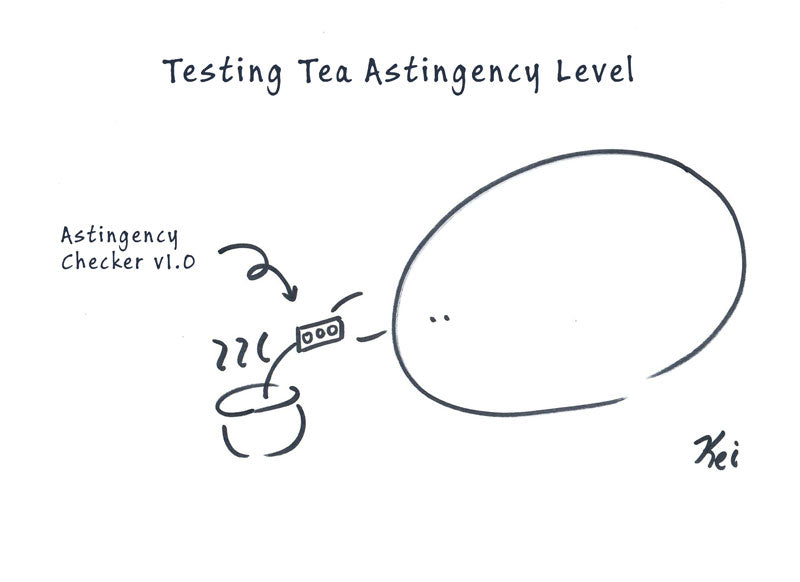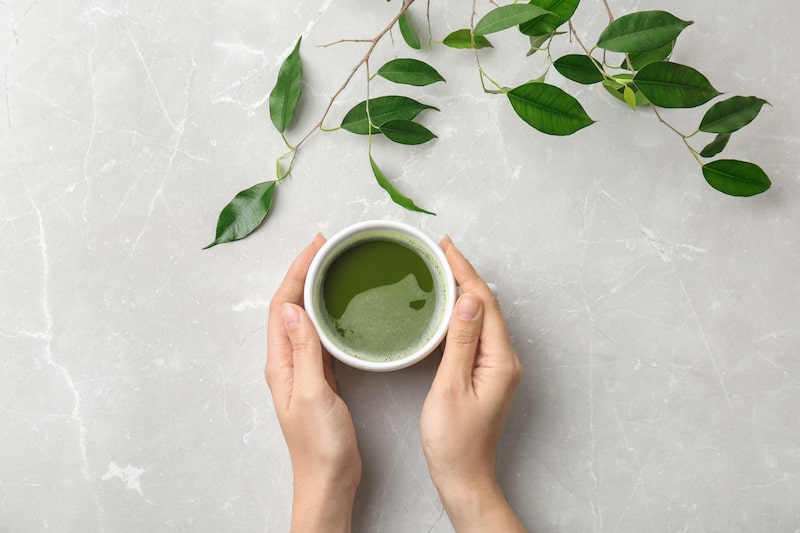Tea Taste Funny I Drank It Will I Be Okay
What Does Astringency Mean For Tea Drinking?

Astringency (渋み) in tea is often misunderstood. It's often confused with the unpleasant taste of bitterness. But in truth, it is actually a physical sensation rather than a taste at all. It is that puckering, dry feeling you experience when you drink red wine or consume unripened fruits, such as green bananas. It can affect the palate and the roof of the mouth. While it usually occurs in tandem with bitter tastes, they are separate from each other.
When we hosted our booth at Tea Festival in 2019, we introduced a card indicating the level of Sweetness, Bitterness and Astringency for each tea. I was surprised that many people asked us "what is astringency?" So I decided to write an entire article explaining "what astringency means" for tea drinkers. Hope you enjoy!
 Sign of Tea at Tea Festival - People were confused what "Astringency" means
Sign of Tea at Tea Festival - People were confused what "Astringency" means
WHAT CAUSES THIS BIZARRE SENSATION?
Tannins and catechins are both antioxidants known as polyphenols. Astringency is caused by tannins in black tea or catechins in green tea. These convert into flavonoids during oxidation. Then, these chemicals bind to the proteins found in saliva, ultimately causing the mouth tissues to constrict. This is the reaction you feel when you consume certain foods or beverages that are astringent. As a matter of fact, black teas are often referred to as tannic when they are actually highly astringent.
(Curious about the best foods to pair with green tea? Discover 10 pairings in this post)
WHY IS ASTRINGENCY SUCH A TOUCHY SUBJECT?
Astringency can be controversial among tea drinkers. Some don't appreciate the sensation and feel or how it can cause the flavor to become overwhelmingly bitter and unbearable. But others concede that a lack of astringency leaves your beverage flat and unimaginative. All agree that there needs to be a level balance in order to produce a delicious cup of tea.
Tea is much more astringent than the majority of foods and drinks. As it was said before, astringency is not a bad thing at all. It all comes down to preference. You also have to remember that all teas have different levels of astringency naturally. If you don't appreciate a particular type of tea, such as Darjeeling, which is highly astringent, you can choose another type of tea. For example, oolong, which is a bit more mild.
Just remember that, not unlike aroma and flavor, coveted astringency is extraordinarily personal. Everyone has different sensations and feels on their palates and it all comes down to what one finds desirable and what one can stand. Because astringency produces a subjective sensation, you can focus on changing how you react to particular feelings, not unlike one can develop an acquired taste for certain wines. You can try teas that you may not be familiar with by thinking critically about how each tea affects your taste buds.
Sometimes astringency is associated with less expensive teas since many higher grade teas tend to have a smoother mouthfeel and taste. But, again, this is an overgeneralization. Teas of all grades and price points come in various astringencies. However, less expensive teas do tend to be watery and thin, so this is a common misconception.
WHERE DO HERBAL TEAS FIT IN?
Herbal teas are made from different plants outside the typical tea plant. They also can pack a strong astringency, though, as a rule, they are not as powerful as black or green teas. The level of astringency is all dependent on the herb that the tea is made from. There are some types that mimic the punch that black tea tannins pack, such as rooibos. The reason most people are drawn to rooibos is because the tea can spend a long time steeping without being overly astringent or bitter the way back tea can get when it is over-steeped.
(Learn more about tannins and green tea science in this post)
There are even many herbs that are more astringent than the common tea plant. Sage and lavender, when brewed as a tea, are so astringent that they give off a feeling of stickiness, giving one a sensation of having a coating in the mouth. That is why many times they are simply included as additional ingredients in a blended tea rather than brewed on their own.

WHAT ARE THE BASIC CATEGORIES OF TEA ASTRINGENCY?
There are basically four different types of astringency found in everyday tea. Though this is definitely not a comprehensive list, most teas can be categorized under one of these headings:
ROUGH
This is the type of astringency that most of us think of when we think of the bitter, drying mouthfeel that can be quite unpleasant. After drinking a tea of this variety, your tongue will feel devoid of moisture and uncomfortable. This is definitely an acquired taste and is not usually one that many tea drinkers seek out. Anything that falls in this category is not something that you should even consider trying...unless you are a seasoned tea lover.
This is a type of astringency that is removed by having sugarcane in the soil. Japanese Green Tea Company's green tea is famous for removing this specific type of astringency.
METALLIC
This astringency is found in many Japanese teas and is unique enough to deserve its own category. It is more like the rough astringency than any other category here, but it is identified more by its powerful organic taste. Some experts speculate that this type of astringency was made as the result of human error. The taste is so pungent, that it is usually unseen in the Western world because it does not fare well in that market.
NEUTRAL
This type is somewhere in the middle. While it will not leave you particularly uncomfortable, it will still dry out your mouth and is not really enjoyable. It is not horrible, and can actually be appealing to many connoisseurs. Even though there are many teas that have these innate properties, almost any tea can be made to match neutral astringency. This occurs if too many leaves were used in the brewing process or if it was steeped for far too long.
STIMULATING
This astringency is what most tea drinkers crave. It has a unique way of causing your tongue to water. But at the same time, simultaneously causing an after-effect of an interesting degree of dryness. It is more akin to a minty, menthol feeling. Astringency also leaves your palette feeling cool and moist.
A good example of this is classic Darjeeling. It's usually associated with higher quality teas and even then, they must be brewed to perfection. In rare cases, this sensation can last for minutes to hours and the after-effects can last even after food consumption. This is what most folks are willing to spend good money on when they choose to invest in a tantalizing tea experience.
In conclusion, astringency is a very important part of what gives every tea its unique character. Knowing which teas provide which particular astringency helps you choose the tea you're likely to enjoy before you buy it.
BUY JAPANESE GREEN TEA WITH LESS ASTRINGENCY
Japanese Green Tea Company's green tea is famous for cutting astringency by growing tea plants in sugarcane soil. Learn more about our best-selling tea which does not have much astringency.
This post was first published in 2019 but it was updated in 2021 just for you.
Related Articles You May Be Interested In




Get Free Bonus Content

If you have ever thought that Green Tea is an "acquired taste" or that it is "too bitter" to enjoy, we're here to change your mind! We want everyone to experience the health benefits of Green Tea and show you that this can be an amazing, refreshing, and delicious drink when made correctly. With just a few tips on how to brew this powerful leaf we can change your mind about the taste and enjoyment of drinking Green Tea.
Don't miss out on the health benefits of tea!
- Improve health
- Increase brain function
- Regulate weight
- Lower your risk of cancers
- Reduce risk of heart disease
- Lowers risk of diabetes
We know that you will love this tips to brewing tea and getting the most flavor and elegance out of every cup. Sign up for Free Japanese Green Tea Club and get this great informative manual on brewing green tea. You will learn what it is that makes it one of the most popular beverages in the world.
Sign up for Free Green Tea Club for to Get The Two Books for Free.
What is GREEN TEA CLUB?
Sign up free to Green Tea Club to get tips and exclusive articles about how to use your matcha and green tea for a healthy lifestyle. Green Tea Club is hosted by Kei Nishida, Author of Cook with Matcha and Green Tea and CEO of Japanese Green Tea Company.
![]()
Get free E-book "Green Tea Science – 12 Scientific Tips for Brewing Green Tea To Taste Better" By Kei Nishida - Value $9.99
![]()
Get free E-book "Matcha Lover's 21st Century Recipe Collection" By Kei Nishida (42 pages recipe book) - Value $9.99
![]()
Get immediate access to 10% Off coupon for your first order and access to Exclusive Coupons and Specials - Value $50+
![]()
Monthly Giveaways - Value $50+
![]()
Access to New Green Tea Recipe and Health Articles - Value $50+
Unsubscribe anytime. It's free!
What do you think about the article? Please comment below or reply me privately here!
Leave a comment
Comments will be approved before showing up.
hollowellmathesembed.blogspot.com
Source: https://www.japanesegreenteain.com/blogs/green-tea-and-health/what-does-astringency-mean-for-tea-drinking

0 Response to "Tea Taste Funny I Drank It Will I Be Okay"
Post a Comment